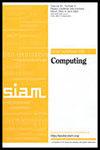来自矩形 PCP 的刚性矩阵
IF 1.6
3区 计算机科学
Q3 COMPUTER SCIENCE, THEORY & METHODS
引用次数: 0
摘要
SIAM 计算期刊》,第 53 卷第 2 期,第 480-523 页,2024 年 4 月。 摘要。我们引入了概率可验证证明(Probabilistically Checkable Proofs,PCPs)的一种变体,我们称之为矩形 PCPs,其中证明被视为正方形矩阵,验证者使用的随机硬币可被划分为两个不相交的集合,一个决定每个查询的行,另一个决定查询的列。我们构建了高效、简短、平滑和(几乎)矩形的 PCP。作为一个关键应用,我们证明了在 NTIME[math] 中,将难语言的证明视为矩阵时,其刚性是无穷大的。这加强并简化了 Alman 和 Chen [FOCS, 2019] 最近在 FNP 中构建显式刚性矩阵的结果。也就是说,我们证明了以下定理:有一个常数 [math],使得存在一种 FNP 机器,对于无限多 [math],在输入 [math] 时输出 [math] 矩阵,其 [math] 中的条目与秩最多 [math] 的矩阵相差 [math](在汉明距离中)。我们首先分析了 Ben-Sasson、Goldreich、Harsha、Sudan 和 Vadhan [SIAM J. Comput.然后,我们展示了如何在 PCP 组合和平滑诱导变换下保持矩形性。这就需要更精细、更强大的矩形性概念,我们将证明外层 PCP 及其变换的矩形性。本文章由计算机程序翻译,如有差异,请以英文原文为准。
Rigid Matrices from Rectangular PCPs
SIAM Journal on Computing, Volume 53, Issue 2, Page 480-523, April 2024.
Abstract. We introduce a variant of Probabilistically Checkable Proofs (PCPs) that we refer to as rectangular PCPs, wherein proofs are thought of as square matrices, and the random coins used by the verifier can be partitioned into two disjoint sets, one determining the row of each query and the other determining the column. We construct PCPs that are efficient, short, smooth, and (almost) rectangular. As a key application, we show that proofs for hard languages in NTIME[math], when viewed as matrices, are rigid infinitely often. This strengthens and simplifies a recent result of Alman and Chen [FOCS, 2019] constructing explicit rigid matrices in FNP. Namely, we prove the following theorem: There is a constant [math] such that there is an FNP-machine that, for infinitely many [math], on input [math] outputs [math] matrices with entries in [math] that are [math]-far (in Hamming distance) from matrices of rank at most [math]. Our construction of rectangular PCPs starts with an analysis of how randomness yields queries in the Reed–Muller-based outer PCP of Ben-Sasson, Goldreich, Harsha, Sudan, and Vadhan [SIAM J. Comput., 36 (2006), pp. 889–974; CCC, 2005]. We then show how to preserve rectangularity under PCP composition and a smoothness-inducing transformation. This warrants refined and stronger notions of rectangularity, which we prove for the outer PCP and its transforms.
Abstract. We introduce a variant of Probabilistically Checkable Proofs (PCPs) that we refer to as rectangular PCPs, wherein proofs are thought of as square matrices, and the random coins used by the verifier can be partitioned into two disjoint sets, one determining the row of each query and the other determining the column. We construct PCPs that are efficient, short, smooth, and (almost) rectangular. As a key application, we show that proofs for hard languages in NTIME[math], when viewed as matrices, are rigid infinitely often. This strengthens and simplifies a recent result of Alman and Chen [FOCS, 2019] constructing explicit rigid matrices in FNP. Namely, we prove the following theorem: There is a constant [math] such that there is an FNP-machine that, for infinitely many [math], on input [math] outputs [math] matrices with entries in [math] that are [math]-far (in Hamming distance) from matrices of rank at most [math]. Our construction of rectangular PCPs starts with an analysis of how randomness yields queries in the Reed–Muller-based outer PCP of Ben-Sasson, Goldreich, Harsha, Sudan, and Vadhan [SIAM J. Comput., 36 (2006), pp. 889–974; CCC, 2005]. We then show how to preserve rectangularity under PCP composition and a smoothness-inducing transformation. This warrants refined and stronger notions of rectangularity, which we prove for the outer PCP and its transforms.
求助全文
通过发布文献求助,成功后即可免费获取论文全文。
去求助
来源期刊

SIAM Journal on Computing
工程技术-计算机:理论方法
CiteScore
4.60
自引率
0.00%
发文量
68
审稿时长
6-12 weeks
期刊介绍:
The SIAM Journal on Computing aims to provide coverage of the most significant work going on in the mathematical and formal aspects of computer science and nonnumerical computing. Submissions must be clearly written and make a significant technical contribution. Topics include but are not limited to analysis and design of algorithms, algorithmic game theory, data structures, computational complexity, computational algebra, computational aspects of combinatorics and graph theory, computational biology, computational geometry, computational robotics, the mathematical aspects of programming languages, artificial intelligence, computational learning, databases, information retrieval, cryptography, networks, distributed computing, parallel algorithms, and computer architecture.
 求助内容:
求助内容: 应助结果提醒方式:
应助结果提醒方式:


